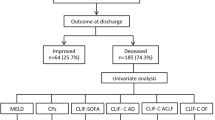Abstract
Introduction
Hepatorenal syndrome (HRS) is one of the serious complications in patients with advanced cirrhosis and ascites. In tertiary centers, most patients were classified as having type 1 HRS for their rapid progressive diseases. However, no significant predictors have been assessed previously for patients with type 1 HRS. In addition to the initial model of end-stage liver disease (MELD) scores and biochemistry parameters, we want to further investigate the prognostic importance of changes in MELD scores and biochemistry parameters over time for patients with type 1 HRS.
Materials and methods
Data from type 1 HRS patients were incorporated, including their demographic, clinical progression, all recording biochemical parameters, therapeutic methods, and outcomes.
Results
A total of 103 patients were included in our study. According to the definition of the International Ascites Club, 67 patients (or 65%) had type 1 HRS whereas 36 (or 35%) had type 2 HRS. According to the multivariate COX proportional hazards regression model, either initial biochemistry parameters or MELD scores were not significantly associated with prognosis. By time-dependent proportional hazards model, each point elevated in creatinine (CRE) and total bilirubin (TBI) levels during the admission increased mortality risk by 29 and 4%, respectively. Increasing albumin level during the admission showed its protective value. Changes in MELD score simple during the admission, which were calculated by CRE and TBI [3.8 × log (bilirubin (mg/dl)] + 9.6 × log [Creatinine (mg/dl) + 6.43], were significant predictor for patients with type 1 HRS.
Conclusion
In patients with type 1 HRS, changes in TBI, CRE, and albumin level during the admission were associated with prognosis. Changes in MELD score simple is superior to initial and changes in MELD scores to predict prognosis in patients with type 1 HRS.


Similar content being viewed by others
References
Gines P, Guevara M, Arroyo V, Rodes J. Hepatorenal syndrome. Lancet 2003;362:1819–1827
Arroyo V, Colmenero J. Ascites and hepatorenal syndrome in cirrhosis: pathophysiological basis of therapy and current management. J Hepatol 2003;38(Suppl 1):S69–S89
Grange JD, Amiot X. Effect of intravenous albumin on renal impairment and mortality in patients with cirrhosis and spontaneous bacterial peritonitis. Gastroenterol Clin Biol 2000;24:378–379
Said A, Williams J, Holden J, Remington P, Gangnon R, Musat A, et al. Model for end stage liver disease score predicts mortality across a broad spectrum of liver disease. J Hepatol 2004;40:897–903
Alessandria C, Ozdogan O, Guevara M, Restuccia T, Jimenez W, Arroyo V, et al. MELD score and clinical type predict prognosis in hepatorenal syndrome: relevance to liver transplantation. Hepatology 2004;41:1282–1289
Schepke M, Appenrodt B, Heller J, Zielinski J, Sauerbruch T. Prognostic factors for patients with cirrhosis and kidney dysfunction in the era of MELD: results of a prospective study. Liver Int 2006;26:834–839
Bambha K, Kim WR, Kremers WK, Therneau TM, Kamath PS, Wiesner R, et al. Predicting survival among patients listed for liver transplantation: an assessment of serial MELD measurements. Am J Transplant 2004;4(11):1798–804
Huo TI, Wu JC, Lin HC, Lee FY, Hou MC, Lee PC, et al. Evaluation of the increase in model for end-stage liver disease (DeltaMELD) score over time as a prognostic predictor in patients with advanced cirrhosis: risk factor analysis and comparison with initial MELD and Child-Turcotte-Pugh score. J Hepatol 2005;42:826–832
Merion RM, Wolfe RA, Dykstra DM, Leichtman AB, Gillespie B, Held PJ. Longitudinal assessment of mortality risk among candidates for liver transplantation. Liver Transplant 2003;9:12–18
Mitzner S, Klammt S, Stange J, Schmidt R. Albumin regeneration in liver support-comparison of different methods. Ther Apher Dial 2006;10(2):108–117
Sundaram V, Al-Osaimi AM, Lewis JJ, Lisman T, Caldwell SH. Severe prolongation of the INR in spur cell anemia of cirrhosis: true-true and related? Dig Dis Sci 2006;51(7):1203–1205
Marik PE, Wood K, Starzl TE. The course of type 1 hepato-renal syndrome post liver transplantation. Nephrol Dial Transplant 2006;21(2):478–482
Author information
Authors and Affiliations
Corresponding author
Rights and permissions
About this article
Cite this article
Yang, YW., Wu, CH., Hu, RH. et al. Longitudinal assessment of prognostic factors for patients with hepatorenal syndrome in a tertiary center. Hepatol Int 4, 507–510 (2010). https://doi.org/10.1007/s12072-010-9180-8
Received:
Accepted:
Published:
Issue Date:
DOI: https://doi.org/10.1007/s12072-010-9180-8




